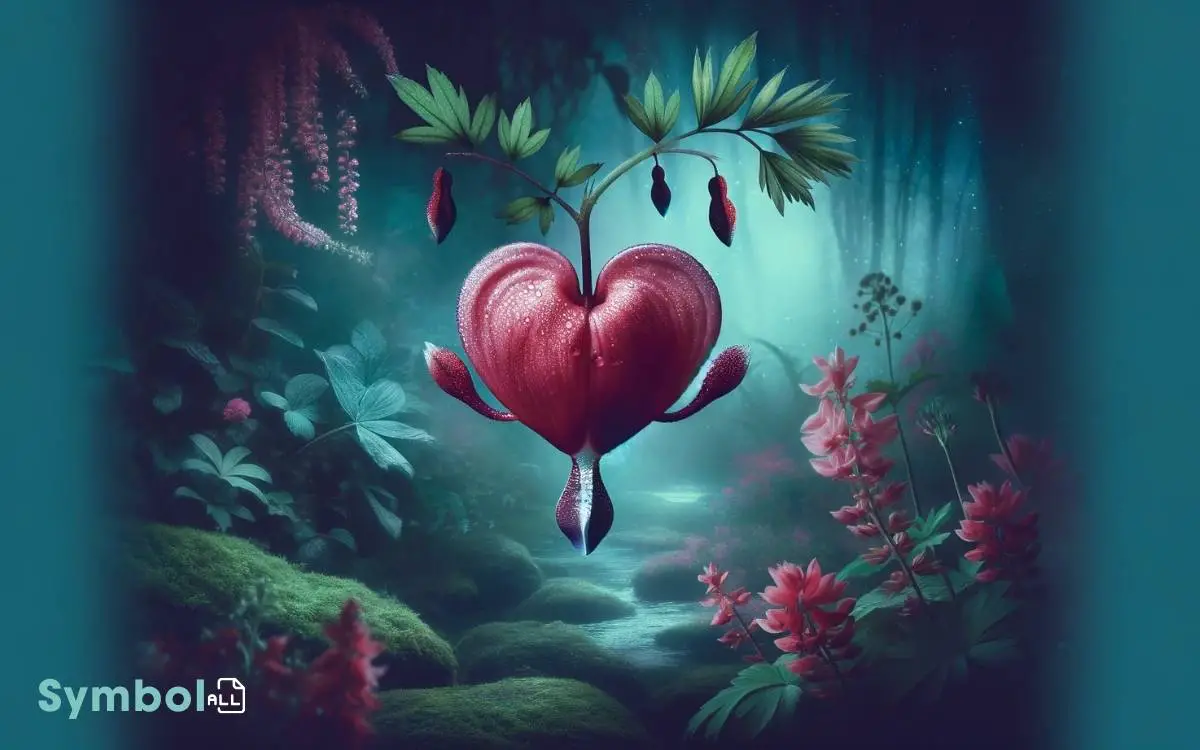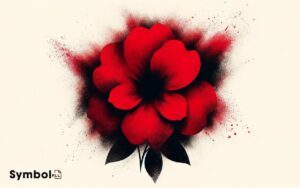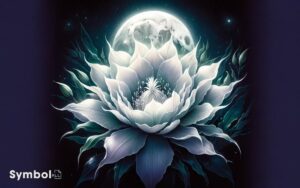Symbolism of Bleeding Heart Flower: An Insightful Guide!
The Bleeding Heart Flower, scientifically known as Lamprocapnos spectabilis, visually embodies deep affection with its heart-shaped blossoms.
Its bilateral symmetry and color gradient symbolize balanced relationships and the depth of human emotions. The pendulous blooms reflect a heart brimming with feelings, emphasizing love’s vulnerability.
The flower’s perennial growth cycle suggests the enduring nature of true love, while alkaloids like isoquinoline indicate potential therapeutic uses, highlighting a dual role in symbolism and medicine.

Key Takeaway
Bleeding Heart Flower Meaning
The bleeding heart flower, with its distinctive heart-shaped blooms and drooping appearance, carries rich symbolism and meaning. This flower is most commonly associated with feelings of love and passion, often representing both the joy and pain that can come with deep emotional connections. Its unique shape, resembling a heart with a drop beneath it, symbolizes a profound romantic love, sometimes with an undertone of loss or sorrow, as if the heart is “bleeding.”
In addition to romantic symbolism, the bleeding heart flower is also connected to themes of compassion, spirituality, and purity. It is sometimes used in Christian symbolism to represent the compassionate heart of Jesus and his sacrifices. This dual aspect of beauty and tragedy makes the bleeding heart a popular choice in gardens and floral arrangements, especially in contexts that celebrate or commemorate love and heartfelt emotion.
Historical Significance
Throughout history, the bleeding heart flower has held significant symbolic and medicinal roles, reflecting its deep-rooted presence in various cultural traditions and herbal practices.
Its botanical name, Lamprocapnos spectabilis, denotes its distinctive morphology, characterized by heart-shaped flowers with a droplet at the base, mimicking a bleeding heart.
This unique appearance has contributed to its symbolic representation of purity, sorrow, and compassion across different cultures.
Scientifically, its compounds have been studied for potential therapeutic benefits, including analgesic and sedative properties, indicating its use in traditional medicine for pain relief and emotional distress.
The plant’s alkaloids, particularly isoquinoline, play an essential role in its pharmacological activities, underscoring the importance of understanding its biochemistry for medicinal applications.
Love and Passion
You’ll find that the Bleeding Heart Flower‘s morphology, particularly its heart-shaped blossoms with droplets at the bottom, visually represents deep affection.
Its structure symbolizes hearts’ vulnerable exposure, illustrating how love opens one up to both profound connection and potential hurt.
This plant has hence become a symbol for eternal passion, where its perennial growth cycle echoes the enduring nature of true love.
Unveiling Deep Affection
The bleeding heart flower symbolizes deep affection, embodying both love and passion with its distinct heart-shaped blooms.
These perennial plants, scientifically known as Lamprocapnos spectabilis, display pendulous, pink to red flowers, each resembling a heart with a droplet at its base, mirroring the essence of profound emotional connections.
The unique morphology of these blooms, particularly the bilateral symmetry and the color gradient from the tips to the base, serves as a metaphor for the layers and depth of human affection.
By dissecting the anatomy of the flower, one observes the intricate arrangement of petals and sepals, which further emphasizes the complexity and multifaceted nature of love.
This botanical marvel, through its visual and structural characteristics, offers a nuanced interpretation of deep-seated affection, resonating with individuals who seek a profound connection with nature’s symbolism.
Hearts Vulnerable Exposure
Embracing the bleeding heart flower reveals the plant’s embodiment of love’s vulnerability and passionate intensity through its exposed, heart-shaped blossoms.
Each petal, meticulously formed, hangs delicately, mirroring an open heart’s susceptibility in the throes of passion.
This floral representation underscores not only the beauty but also the fragility inherent in love’s expression.
The pendulous blooms, with their distinctive shape and vivid hues, serve as a botanical metaphor for an open heart, unguarded and exposed, inviting an intimate connection yet susceptible to the elements.
Through detailed examination, you’ll observe the flower’s anatomy sepals, petals, and stamens—arranged in such a way to symbolize the complex nature of love, emphasizing the balance between revealing one’s deepest emotions and the inherent risk of such openness.
Eternal Passion Symbol
Beyond its representation of love’s vulnerability, the bleeding heart flower also embodies the concept of eternal passion through its resilient blooming cycle and vivid coloring.
This perennial plant, scientifically known as Dicentra spectabilis, thrives in temperate climates, showcasing its heart-shaped flowers from early spring to late summer.
Its enduring presence in gardens symbolizes unwavering love and passion that withstands the test of time.
| Aspect | Detail | Symbolism |
|---|---|---|
| Bloom Cycle | Early spring to late summer | Endurance of passion |
| Color | Vivid pink and white | Intensity and purity of love |
| Shape | Heart-shaped | Direct symbolism of love |
| Climate Tolerance | Temperate | Resilience in love |
Sorrow and Loss
You’ll find the Bleeding Heart flower embodies the grieving process through its distinct heart-shaped blooms, symbolizing the weight of sorrow and heartache.
Its unique morphology, especially the droplets at the petal tips, serves as a floral representation of tears, illustrating the profound connection to human emotions during times of loss.
Additionally, the plant’s role in mourning traditions underscores its deep cultural significance in articulating grief and remembrance.
Grieving Process Symbolism
How does the Bleeding Heart flower embody the intricate emotions of sorrow and loss during the grieving process, reflecting its profound symbolism in botanical and cultural contexts?
This perennial plant, with its distinctive heart-shaped flowers and pendulous drops, mirrors the heavy heart of grief.
Scientifically known as Lamprocapnos spectabilis, its morphology—a heart, pierced, bleeding—captures the essence of emotional pain and the overwhelming sense of loss.
Culturally, it’s often associated with an ability to express deep, unspoken feelings of mourning, providing a botanical metaphor for the indescribable.
Through its growth cycle, the Bleeding Heart’s seasonal disappearance and reemergence symbolize the journey of grief: an initial overwhelming presence that gradually recedes, yet leaves a lasting mark on the landscape of one’s emotions.
Heartaches Floral Representation
Building on the deep emotional symbolism of the Bleeding Heart flower, let’s explore how other flora encapsulate heartache, sorrow, and loss through their unique botanical characteristics and lifecycle patterns.
The Wilted Rose, for instance, embodies the transient nature of love and the inevitable descent into sorrow as its petals fall.
This phenomenon, known as senescence, mirrors the human experience of loss, reflecting the impermanence of relationships.
Similarly, the Cypress tree, with its evergreen foliage, stands as a symbol of mourning, illustrating the enduring nature of grief.
Its upright form and pointed leaves suggest an eternal reaching out for what was lost, embodying the longing and resilience found in the heart of those who grieve.
These species, through their growth and decay, offer poignant insights into the complexities of emotional pain.
Mourning Traditions Connection
Throughout history, various cultures have often incorporated specific plants in their mourning traditions, highlighting the deep-seated connection between flora and the expression of sorrow and loss.
The bleeding heart flower, scientifically known as Lamprocapnos spectabilis, stands out in this domain due to its unique morphology and symbolic significance.
Its heart-shaped flowers, with droplets resembling blood at the bottom, serve as a poignant emblem of grief and undying love.
This plant’s phenology, blooming in the spring, parallels the cycle of life and death, offering a metaphorical representation of resurrection and hope amidst mourning.
Culturally, its inclusion in funeral bouquets and graveside plantings articulates a silent language of bereavement, encapsulating complex emotions that words often fail to convey, fostering a sense of solace and communal empathy during times of loss.
Unconditional Love
In the domain of botany, the Bleeding Heart flower symbolizes unconditional love due to its unique heart-shaped blossoms, which epitomize an enduring emotional connection.
This representation is deeply rooted in the plant’s morphology and phenology, illustrating nature’s intricate language of love.
- Dicentra spectabilis: The botanical name, hinting at its striking appearance.
- Bilateral Symmetry: Each flower’s perfect symmetry symbolizes balance in relationships.
- Pendulous Blooms: Their downward droop signifies a heart full of emotion.
- Perennial Growth: Reflects the lasting nature of true love, returning year after year.
Understanding these elements enhances appreciation for the Bleeding Heart’s role in conveying profound emotional states, specifically the depth and resilience of unconditional love.
Cultural Interpretations
Moving beyond its botanical significance, let’s explore how various cultures interpret the Bleeding Heart flower‘s symbolism.
In Eastern traditions, this perennial is often seen as embodying compassion and emotional availability.
The flower’s unique appearance, with its heart-shaped blossoms and pendulous drops, has led to associations with deep sentiment and vulnerability.
Scientifically known as Lamprocapnos spectabilis, its morphology—specifically the ‘bleeding’ aspect—resonates with themes of profound love and sorrow across different cultural narratives.
In Victorian floriography, the Bleeding Heart symbolizes rejected love, emphasizing the flower’s dual capacity to represent both the heights of affection and the depths of desolation.
This dichotomy captures the complex human emotions tied to love and loss, making it a potent symbol within cultural contexts that value emotional depth and expressivity.
Gardening and Spirituality
Exploring the world of gardening reveals how nurturing the Bleeding Heart flower can deepen one’s spiritual connection to nature, illustrating a symbiotic relationship between plant care and personal growth.
You’ll find that this process:
- Enhances your understanding of Dicentra spectabilis observing its unique growth cycle and adaptation mechanisms.
- Cultivates patience and mindfulness through the meticulous care required for the plant’s flourishing.
- Provides insight into the ecological balance, emphasizing the Bleeding Heart’s role in attracting pollinators and supporting biodiversity.
- Encourages a deeper reflection on life cycles, as you witness the plant’s dormancy and rebirth, mirroring personal transformation.
This journey not only enriches your botanical knowledge but also fosters a profound spiritual awakening, rooted in the rhythms of the natural world.
Conclusion
In the tapestry of your garden, the bleeding heart flower emerges as a poignant emblem of the complex spectrum of human emotions, from the fervent whispers of love to the silent echoes of sorrow.
Its delicate petals, steeped in historical and cultural narratives, serve as a vivid reminder of nature’s intrinsic ability to mirror our deepest sentiments.
As you tend to these living metaphors, you’re not just cultivating plants, but nurturing a garden of emotions that blooms with every season of the soul.





